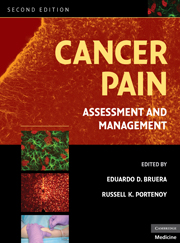Book contents
- Frontmatter
- Contents
- Contributors
- Preface
- SECTION I MECHANISMS AND EPIDEMIOLOGY
- SECTION II EPIDEMIOLOGY AND SYNDROMES
- SECTION III ASSESSMENT
- SECTION IV PHARMACOLOGICAL TREATMENT
- SECTION V OTHER INTERVENTIONAL STRATEGIES
- SECTION VI REHABILITATION AND PSYCHOLOGICAL INTERVENTIONS
- SECTION VII THE ROLE OF ANTINEOPLASTIC THERAPIES IN PAIN CONTROL
- SECTION VIII PAIN IN SPECIAL POPULATIONS
- SECTION IX DIFFICULT PAIN PROBLEMS
- SECTION X SYSTEMS OF CARE
- 29 Integrating cancer pain management into hospice practice and institution-based palliative care programs
- 30 Pain in medical illness: ethical and legal foundations
- 31 Understanding clinical trials in pain research
- 32 Legal and regulatory aspects of opioid treatment: the United States experience
- 33 Role of family caregivers in cancer pain management
- 34 Cancer pain and palliative care in the developing world
- Index
- Plate section
- References
32 - Legal and regulatory aspects of opioid treatment: the United States experience
from SECTION X - SYSTEMS OF CARE
Published online by Cambridge University Press: 06 July 2010
- Frontmatter
- Contents
- Contributors
- Preface
- SECTION I MECHANISMS AND EPIDEMIOLOGY
- SECTION II EPIDEMIOLOGY AND SYNDROMES
- SECTION III ASSESSMENT
- SECTION IV PHARMACOLOGICAL TREATMENT
- SECTION V OTHER INTERVENTIONAL STRATEGIES
- SECTION VI REHABILITATION AND PSYCHOLOGICAL INTERVENTIONS
- SECTION VII THE ROLE OF ANTINEOPLASTIC THERAPIES IN PAIN CONTROL
- SECTION VIII PAIN IN SPECIAL POPULATIONS
- SECTION IX DIFFICULT PAIN PROBLEMS
- SECTION X SYSTEMS OF CARE
- 29 Integrating cancer pain management into hospice practice and institution-based palliative care programs
- 30 Pain in medical illness: ethical and legal foundations
- 31 Understanding clinical trials in pain research
- 32 Legal and regulatory aspects of opioid treatment: the United States experience
- 33 Role of family caregivers in cancer pain management
- 34 Cancer pain and palliative care in the developing world
- Index
- Plate section
- References
Summary
Introduction
Pain is one of the most common and feared symptoms of cancer. Persons may experience pain at the time of diagnosis, during therapy, and even after the disease has been successfully treated. Although precise prevalence data are not available, a recent systematic review found that 59% of patients receiving anticancer treatment were experiencing pain as were 64% of those with metastatic disease; furthermore, about a third of patients had pain after “curative treatment.” More than a third of those with pain rated it as moderate to severe. Thus, more than 20 years after the World Health Organization introduced the analgesic ladder and provided guidelines to improve the treatment of cancer pain worldwide, there is clear evidence that the “prevalence of pain remains unacceptably high in patients with cancer.”
Essentially all the pain of cancer can be relieved with a multidimensional approach that includes careful assessment of the pain syndrome and appropriate use of the variety of therapies that are available. Yet persons with cancer, even those at the end of life, continue to suffer needlessly from pain. Almost three quarters of the general public surveyed in 1997 feared dying in pain; others reported they were more afraid of being in pain at the end of life than they were of death.
The reasons for the undertreatment of cancer pain have been thoroughly documented over the last quarter-century.
- Type
- Chapter
- Information
- Cancer PainAssessment and Management, pp. 583 - 596Publisher: Cambridge University PressPrint publication year: 2009
References
- 1
- Cited by



